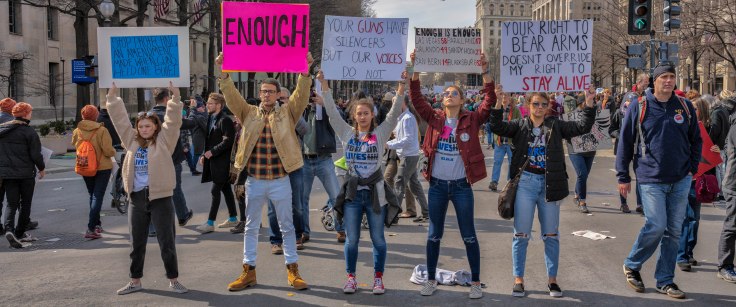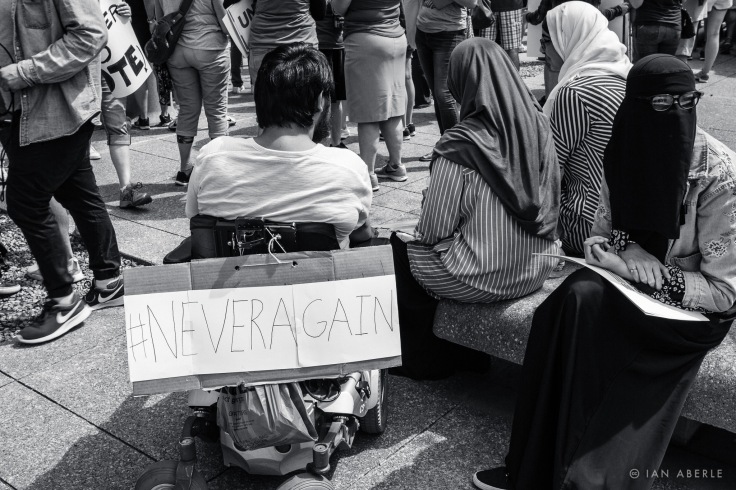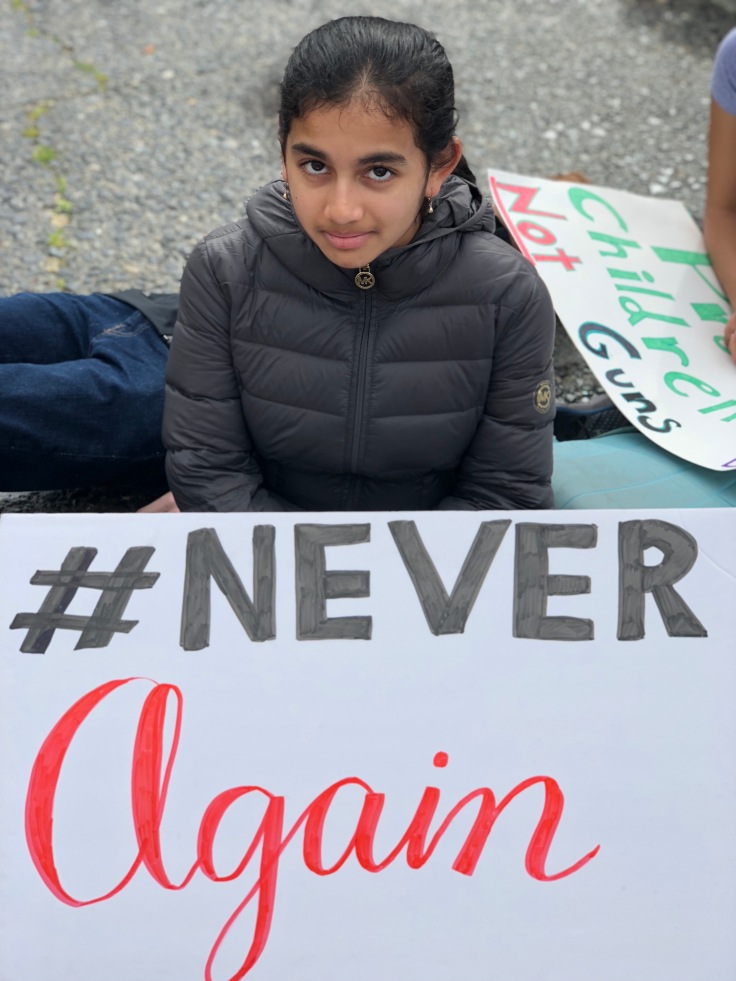By Morgan Stiles
Following the massacre that occurred on February 14th, 2018 at Marjory Stoneman Douglas High School, in Parkland Florida, a student-led activist group emerged to fight for gun control. This social movement, #NeverAgain, set out to push for policy changes that included stricter background checks and a ban on assault rifles. They also planned a nationwide protest, “March for Our Lives”, which brought together millions of people that demanded their lives be protected. According to Vox News, the March for Our Lives turnout was estimated to be between 1.2 – 2 million people in the U.S., making it one of the largest protests in American History (Lopez, 2018). This makes one wonder: how did a bunch of high school students lead a national activist group with a following of millions? The answer to this question is the utilization of digital technology. Through social media, students became empowered leaders who sought to fight for change.

[Image Source: Mobilus In Mobili (Photographer). (2018, March 24). March for our lives enough [digital image]. Retrieved from https://www.flickr.com/photos/mobili/27126435158/].
How did they do it?
Through digital technology, leaders can use their voice to reach mass audiences all over the world. The Parkland students have used Twitter in particular as their choice of digital platform being that it provides affordances that allow users to live-stream events and spread messages to what seems like an infinite audience. The most useful affordance of Twitter that the students have taken advantage of is the hashtag (#). Parkland students dubbed #NeverAgain to build a grass-roots network of activists and lead the public to join in national walkouts around the country to protest gun violence. “The students at Stoneman Douglass aren’t like those who witness previous mass shootings at schools…They’re digital natives, at one with the language and power of smartphones and social media” (Campo-Flores & Hong, 2018). In other words, these digital savvy students have taken advantage of their tools of expertise to initiate change and become leaders of a mass movement to end gun violence. However, although the power of technology has contributed largely to the success of this social movement, it takes more than just being digital savvy to inspire change and gather a mass following. It takes being a leader.
More than tech-savvy
Just because one has expertise in digital technology does not necessarily mean that they can become effective leaders. Digital social movements are fueled by a mindset build around particular principles. According to Henry Timms in Harvard Business Review, these guiding principles include: (1) think movement, not initiative, (2) think upload, not download, (3) think current, not currency, and (4) think tools, not rules. In short, these principles are based on the notion of motivating others. For example, rather than focusing on setting out to execute an initiative, a focus should be placed on growing a movement. Inspiring others to follow and support your cause is essential. Additionally, ‘think upload, not download’ refers to not telling others what they should be doing or how they should be doing it. Instead, a focus should be placed on encouraging peoples’ desire to make the movement their own and to share their own experiences. ‘Think current, not currency’ refers to understanding the you cannot have complete control in a movement, rather connecting with the broad power of social media communities depletes total control. Lastly, ‘think tools, not rules’ is a reminder that the core function of the movement is to empower and provide the right resources to support the efforts of the movement.
These guiding principles are useful in regard to helping organizations or individuals create movements through digital technologies. “The challenge ahead, for any organization trying to create movement at scale, is not simply to master social media, but to learn to shape and support social communities. This will require not just new tools, but new mindsets” (Tills, 2018). In other words, creating social change with social media is more than just learning how to use the tools, but it also involves shaping the affordances to meet your needs, incorporating leadership skills, and understanding how to motivate others.
These guiding principles and leadership mindset are extremely relevant to what the Parkland students have established through the #NeverAgain movement. Although the students are all tech-savvy and have mastered the ins-and-outs of technology, it has taken more than these skills to initiate followership and promote change. The key take-away amongst these principles that the Parkland students have embraced, is inspiring others to join their cause.
Inspiring others to follow
Individuals have no ability to lead unless there are others who are willing to follow. In other words, unless there are those who follow, the concept of a leader has little to no value. The Parkland students are an example of individuals who successfully articulated a compelling vision and served as a model for action. They worked on identifying needed change and creating a vision to guide this change. This vision and actions inspired a mass audience to follow their vision of a safer nation.

[Image Source: Aberle, I. (Photographer). (2018, March 24). March for our lives [digital image]. Retrieved from https://www.flickr.com/photos/ianaberle/40978911462/].
One of the key aspects of being a leader is inspiring unity and motivating others to function as a collective team. According to Dr. Brent Ruben in, “What Leaders Need to Know and Do: A Leadership Competencies Scorecard”, communication is one of the most fundamental of leadership competencies. “Competent leaders are adept at using language to “mobilize action” and to find ways to frame, or reframe situations so as to overcome obstacles” (Ruben, 2006, p.37). What made the #NeverAgain movement so successful was the Parkland students’ way of framing the situation and using communication to unite the public. In other words, in addition to using technology to spread a message and proposing a plan to combat the issue of gun violence, the Parkland students acted as competent leaders in the way in which they used language to mobilize action. For example, Parkland student, Cameron Kasky, used “we” rather than “I” language at a #NeverAgain rally. “We are strong, but together we’re unstoppable” quoted Kasky (Witt, 2018). Through this collective use of language, followers are motivated and inspired to join the leaders of the movement. The leaders encourage them they they play a vital role in the success of the social movement.
The future of social movements
In conclusion, leadership is a process. Although the wide spread of digital technology has impacted who and how people can lead, the driving force of constructing a plan and gathering a followership are still essential. The #NeverAgain movement provides as one example of how high school students were successfully able to take their experiences from a tragedy and turn it into a movement for change through the use of technology. Such as in every organization or team, success is not guaranteed. “But the potential to inspire more widespread and passionate empathy and sympathy through these demonstrations could crack the key problem facing the gun control movement today” (Lopez, 2018). Hence, although the use of digital technology does not guarantee a movements’ success, these digital technologies provide the tools necessary to inspire change.

[Image Source: Rapport, S. (Photographer). (2018, March 14). National walkout for gun control [digital image]. Retrieved from https://www.flickr.com/photos/indivisiblesf/39252496720/in/photolist-22NBiJQ-cXoVeW-egXCCS-51T3BK-SQZauK-FUnr6H-rpHAoi-24tPMzs-FQBWfv-23bfDxt-FwESSF-24ESEzo-22GKM3C-G6DQig-akyhxg-awiiKw-pzbfUv-FNyjgK-25y5ebA-22HL5fs-V489Kv-FchYXW-FNymvz-PewtkT-pJTFCk-FNyi44-FNykur-E1MJ3v-qF9XAM-FNyjsM-FNyiGZ-5RnqGa-G6DMfx-25oZ4qh-25sxgYS-226D2jG-22x7tjj-25oDWao-25bMsfk-SWJeYr-HmFkDS-QSZMXJ-Hk5GdU-5wC4S4-25uPvgu-568bEE-51T2xk-51T7Yr-25qZ4nj-24tVaS3].
References
Campo-Flores, A. & Hong, N. (2018, Feb. 23). How the Florida school shooting turned into a gun-control movement: Digital savvy students naturally turned to social media, invoking #NeverAgain to campaign for change in wake of attack. The Wall Street Journal. Retrieved from: http://www.wsj.com/articles/how-the-florida-school-shooting-turned-into-a-gun-control-movement-1519416915
Lopez, G. (2018, March, 26). It’s official: March for Our Lives was one of the biggest youth protests since the Vietnam War. Vox News. Retrieved from: https://www.vox.com/policy-and-politics/2018/3/26/17160646/march-for-our-lives-crowd-size-count
Ruben, B.D. (2006). What leaders need to know and do: A leadership competencies scorecard. Washington, DC: National Association of College and University Business Officers.
Timms, H. (2013, March, 25). Creating social change with social media. Harvard Business Review. Retrieved from: http:hbr.org/2013/03/creating-social-change-with-so
Witt, E. (2018, Feb. 19). How the survivors of Parkland began the Never Again movement. The New Yorker. Retrieved from: https://www.newyorker.com/news/news-desk/how-the-survivors-of-parkland-began-the-never-again-movement

Leave a comment